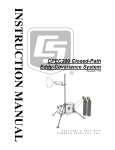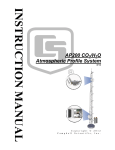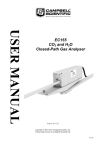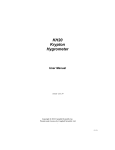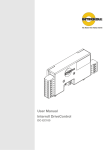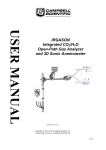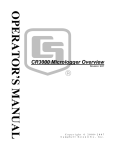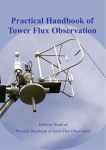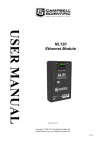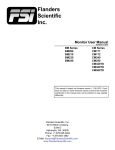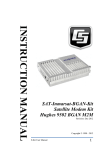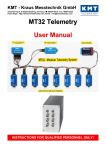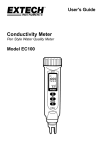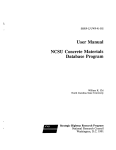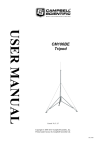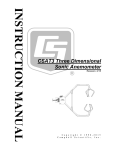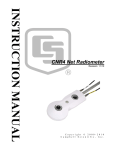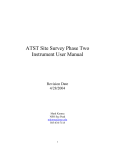Download CPEC200 Closed-Path Eddy-Covariance System
Transcript
CPEC200 Closed-Path Eddy-Covariance System 1/13 C o p y r i g h t © 2 0 1 3 C a m p b e l l S c i e n t i f i c , I n c . Warranty “PRODUCTS MANUFACTURED BY CAMPBELL SCIENTIFIC, INC. are warranted by Campbell Scientific, Inc. (“Campbell”) to be free from defects in materials and workmanship under normal use and service for twelve (12) months from date of shipment unless otherwise specified in the corresponding Campbell pricelist or product manual. Products not manufactured, but that are re-sold by Campbell, are warranted only to the limits extended by the original manufacturer. Batteries, fine-wire thermocouples, desiccant, and other consumables have no warranty. Campbell's obligation under this warranty is limited to repairing or replacing (at Campbell's option) defective products, which shall be the sole and exclusive remedy under this warranty. The customer shall assume all costs of removing, reinstalling, and shipping defective products to Campbell. Campbell will return such products by surface carrier prepaid within the continental United States of America. To all other locations, Campbell will return such products best way CIP (Port of Entry) INCOTERM® 2010, prepaid. This warranty shall not apply to any products which have been subjected to modification, misuse, neglect, improper service, accidents of nature, or shipping damage. This warranty is in lieu of all other warranties, expressed or implied. The warranty for installation services performed by Campbell such as programming to customer specifications, electrical connections to products manufactured by Campbell, and product specific training, is part of Campbell’s product warranty. CAMPBELL EXPRESSLY DISCLAIMS AND EXCLUDES ANY IMPLIED WARRANTIES OF MERCHANTABILITY OR FITNESS FOR A PARTICULAR PURPOSE. Campbell is not liable for any special, indirect, incidental, and/or consequential damages.” Assistance Products may not be returned without prior authorization. The following contact information is for US and international customers residing in countries served by Campbell Scientific, Inc. directly. Affiliate companies handle repairs for customers within their territories. Please visit www.campbellsci.com to determine which Campbell Scientific company serves your country. To obtain a Returned Materials Authorization (RMA), contact CAMPBELL SCIENTIFIC, INC., phone (435) 227-9000. After an applications engineer determines the nature of the problem, an RMA number will be issued. Please write this number clearly on the outside of the shipping container. Campbell Scientific's shipping address is: CAMPBELL SCIENTIFIC, INC. RMA#_____ 815 West 1800 North Logan, Utah 84321-1784 For all returns, the customer must fill out a "Statement of Product Cleanliness and Decontamination" form and comply with the requirements specified in it. The form is available from our web site at www.campbellsci.com/repair. A completed form must be either emailed to [email protected] or faxed to (435) 227-9106. Campbell Scientific is unable to process any returns until we receive this form. If the form is not received within three days of product receipt or is incomplete, the product will be returned to the customer at the customer's expense. Campbell Scientific reserves the right to refuse service on products that were exposed to contaminants that may cause health or safety concerns for our employees. Table of Contents PDF viewers: These page numbers refer to the printed version of this document. Use the PDF reader bookmarks tab for links to specific sections. 1. Introduction .................................................................1 2. Cautionary Statements...............................................1 3. Initial Inspection .........................................................2 4. Overview......................................................................2 4.1 System Components.............................................................................2 4.1.1 Standard Components ...................................................................2 4.1.1.1 EC155 Gas Analyzer ..........................................................2 4.1.1.2 EC100 Electronics..............................................................3 4.1.1.3 CPEC200 Enclosure...........................................................3 4.1.1.4 CPEC200 Pump Module ....................................................4 4.1.2 Optional Components ...................................................................4 4.1.2.1 CR3000 Datalogger............................................................4 4.1.2.2 NL115 or CFM100 Storage Module ..................................5 4.1.2.3 CPEC200 Valve Module ....................................................6 4.1.2.4 CSAT3A Sonic Anemometer Head....................................6 4.1.2.5 Pressure Sensor ..................................................................7 4.1.2.6 Carrying Cases ...................................................................7 4.1.2.7 Enclosure Mounting Options..............................................7 4.1.3 Common Accessories....................................................................7 4.1.4 Support Software ..........................................................................9 4.1.5 Replacement Parts.......................................................................10 4.2 Theory of Operation...........................................................................11 4.2.1 EC155 Gas Analyzer...................................................................11 4.2.2 CSAT3A Sonic Anemometer Head ............................................12 4.2.3 Valve Module..............................................................................12 4.2.4 Pump Module..............................................................................14 4.3 Specifications .....................................................................................15 5. Installation .................................................................15 5.1 Mounting............................................................................................16 5.1.1 Support Structure ........................................................................16 5.1.2 Mount Enclosures .......................................................................16 5.1.3 Install EC Sensors .......................................................................17 5.2 Plumbing ............................................................................................19 5.2.1 Pump Module..............................................................................19 5.2.2 Zero/Span....................................................................................20 5.3 Wiring ................................................................................................21 5.3.1 Ground Connections ...................................................................21 5.3.2 EC Sensor Cables........................................................................22 i Table of Contents 5.4 5.5 5.6 5.7 5.8 5.3.3 Pump Module Cable................................................................... 25 5.3.4 Apply Power............................................................................... 25 Configure the Program ...................................................................... 25 System Configuration Variables........................................................ 26 5.5.1 Sonic Anemometer Azimuth ...................................................... 26 5.5.2 CO2 Span Cylinder Concentration.............................................. 26 5.5.3 H2O Span Dew Point Temperature............................................. 26 5.5.4 Sample Intake Flow Rate ........................................................... 27 5.5.5 Zero/Span Gas Flow Rate........................................................... 27 5.5.6 EC155 Manual Power-down ...................................................... 27 5.5.7 Sampling Mode .......................................................................... 27 System Control Constants ................................................................. 27 5.6.1 Automatic Zero/Span ................................................................. 27 5.6.2 Other System Constants ............................................................. 28 CPEC200 Operating Modes .............................................................. 28 Verify Proper Operation .................................................................... 29 6. Zero and Span ...........................................................30 6.1 6.2 6.3 Introduction ....................................................................................... 30 Automatic Zero and Span.................................................................. 31 Manual Zero and Span....................................................................... 33 6.3.1 Onsite (Keypad) ......................................................................... 34 6.3.2 Remote (LoggerNet) .................................................................. 35 7. Maintenance and Troubleshooting..........................36 7.1 7.2 7.3 7.4 Enclosure Desiccant .......................................................................... 36 EC155 Intake Filter ........................................................................... 36 EC155 Windows................................................................................ 37 EC155 Chemical Bottles ................................................................... 37 8. Repair .........................................................................37 Appendices A. CPEC200 Diagnostics.............................................A-1 B. Using Swagelok® Fittings ......................................B-1 B.1 B.2 Assembly ......................................................................................... B-1 Common Replacement Parts ........................................................... B-2 C. Output Variables .....................................................C-1 Figures 4-1. 4-2. 4-3. 4-4. 4-5. EC155 closed-path CO2/H2O gas analyzer.......................................... 2 EC100 electronics module................................................................... 3 CPEC200 system enclosure................................................................. 3 CPEC200 pump module ...................................................................... 4 CR3000 datalogger.............................................................................. 5 ii Table of Contents 4-6. 4-7. 4-8. 4-9. 4-10. 4-11. 4-12. 4-13. 4-14. 4-15. 5-1. NL115 (left) and CFM100 (right) ........................................................5 CFMC2G 2GB CompactFlash® memory card ....................................5 CPEC200 valve module .......................................................................6 CSAT3A sonic anemometer head ........................................................7 17752 USB memory card reader/writer ...............................................9 Intake filter of EC155.........................................................................10 Single desiccant pack .........................................................................10 Humidity indicator card .....................................................................11 EC155 gas analyzer............................................................................11 CSAT3A sonic anemometer head ......................................................12 CPEC200 enclosure, pump module, and EC100 mounted to legs of CM110-series tripod ...........................................................17 5-2. CM210 mounting bracket on a tripod mast........................................18 5-3. Mounting of EC155 and CSAT3A.....................................................18 5-4. Plumbing connections (shown without mounting hardware, CSAT3A, electrical connections, and tripod or tower)...................19 5-5. Connecting pump tube from EC155 analyzer to pump module .........20 5-6. Enclosure and tripod grounded to a copper-clad grounding rod ........22 5-7. EC155 electrical connections (mounting hardware not shown) .........22 5-8. Wiring of power and communications ...............................................23 5-9. Wiring to EC100 electronics ..............................................................24 5-10. Wiring to CPEC200 enclosure ...........................................................24 B-1. Swagelok® insert .............................................................................B-3 B-2. Front and back Swagelok® ferrules .................................................B-4 B-3. Swagelok® plug...............................................................................B-5 B-4. A Swagelok® cap ............................................................................B-6 Tables 5-1. 5-2. 5-3. 5-4. 6-1. A-1. B-1. B-2. B-3. B-4. B-5. SDM Wiring.......................................................................................23 Configurable Constants in CPEC200 Automatic Zero/Span..............28 Other System Constants .....................................................................28 CPEC200 Modes of Operation...........................................................29 Automatic Zero/Span Sequence .........................................................32 Summary of bit numbers indicating conditions outside normal operating range ............................................................................ A-1 Available plastic tubing sizes, construction, and usage guidelines ..B-2 Dimensions and part numbers for Swagelok® inserts .....................B-3 Dimensions and part numbers for Swagelok® ferrules....................B-4 Dimensions and part numbers for Swagelok® plugs .......................B-5 Dimensions and part numbers for Swagelok® caps.........................B-6 iii Table of Contents iv CPEC200 Closed-Path Eddy-Covariance System 1. Introduction The CPEC200 is a closed-path, eddy-covariance (EC) flux system used for long-term monitoring of atmosphere–biosphere exchanges of carbon dioxide, water vapor, heat, and momentum. This complete, turn-key system includes a closed-path gas analyzer (EC155), a sonic anemometer head (CSAT3A), datalogger (CR3000), sample pump, and optional valve module for automated zero and span. Before using the CPEC200, please study: • Section 2, Cautionary Statements • Section 3, Initial Inspection • Section 5, Installation Operational instructions critical to the preservation of the system are found throughout this manual. Before using the CPEC200, please study the entire manual. Further information pertaining to the CPEC200 can be found in the Campbell Scientific publications EC155 CO2 and H2O Closed-Path Gas Analyzer and EC100 Electronics with Optional CSAT3A 3D Sonic Anemometer manual, available at www.campbellsci.com. Other manuals that may be helpful include: • • • • • • • • • NOTE 2. CR3000 Micrologger Operator’s Manual CFM100 CompactFlash® Module Instruction Manual NL115 Ethernet and CompactFlash® Module Instruction Manual Application Note 3SM-F, PC/CF Card Information LoggerNet Instruction Manual, Version 4.1 ENC10/12, ENC12/14, ENC14/16, ENC16/18 Instruction Manual CM106 Tripod Instruction Manual Tripod Installation Manual Models CM110, CM115, CM120 CSAT3 Three Dimensional Sonic Anemometer This user manual applies specifically to version 1.3 of the CPEC200 CRBasic program. Cautionary Statements • WARNING: o Do not connect or disconnect the EC155 gas analyzer head or CSAT3A sonic anemometer head from the EC100 electronics while the EC100 is powered. Doing so can result in unpredictable performance of the system or damage to the instrument head. o Grounding electrical components in the measurement system is critical. Proper earth (chassis) grounding will ensure maximum electrostatic discharge (ESD) protection and higher measurement accuracy. 1 CPEC200 Closed-Path Eddy-Covariance System o o o o 3. Use care when connecting and disconnecting tube fittings to avoid introducing dust or other contaminants. Do not overtighten the tube fittings. Consult Appendix B, Using Swagelok® Fittings, for information on proper connection. The CPEC200 power source should be designed thoughtfully to ensure uninterrupted power. If needed, contact a Campbell Scientific applications engineer for assistance. Retain all spare caps and plugs as these are required when shipping or storing the CPEC200 system. Initial Inspection Upon receipt of the CPEC200, inspect the packaging and contents for damage. File damage claims with the shipping company. Model numbers are found on each product. On cables, the model number is often found at the connection end of the cable. Check this information against the enclosed shipping documents to verify the expected products and the correct lengths of cable are included. 4. Overview The CPEC200 is a closed-path EC flux system used for long-term monitoring of atmosphere–biosphere exchanges of carbon dioxide, water vapor, heat, and momentum. 4.1 System Components The CPEC200 consists of several components, some of which are optional. Some additional accessories are required to complete a fully functioning CPEC200 system and are described and illustrated in the sections that follow. 4.1.1 Standard Components Standard with the CPEC200 are the CPEC200 system enclosure, EC155 gas analyzer, EC100 electronics, and CPEC200 pump module. 4.1.1.1 EC155 Gas Analyzer The EC155 is a closed-path, infrared CO2/H2O gas analyzer. It shares integrated electronics (EC100 electronics) with the CSAT3A sonic anemometer head. For detailed information and specifications, see the EC155 manual. The EC155 is included as part of the CPEC200. FIGURE 4-1. EC155 closed-path CO2/H2O gas analyzer 2 CPEC200 Closed-Path Eddy-Covariance System 4.1.1.2 EC100 Electronics The EC100 electronics module controls the EC155 and CSAT3A. It is housed in its own enclosure and must be mounted within 3 m of the sensors. FIGURE 4-2. EC100 electronics module 4.1.1.3 CPEC200 Enclosure The CPEC200 enclosure houses the CR3000 datalogger, control electronics, the optional valve module, and communications and power terminals. Several options for mounting to a tower, tripod body or leg, or large diameter pole can be specified when ordering the system. FIGURE 4-3. CPEC200 system enclosure 3 CPEC200 Closed-Path Eddy-Covariance System 4.1.1.4 CPEC200 Pump Module The pump module uses a small, low-power diaphragm pump to draw air through the EC155 sample cell. The pumping speed is automatically controlled to maintain the volumetric flow at the setpoint (3 to 7 LPM). The pump module is temperature controlled to keep the pump in its operating temperature range of 2°C to 55°C. The pump module includes a large-capacity filter to protect the pump from contamination and dampen pressure fluctuations in the sample cell caused by the pump. FIGURE 4-4. CPEC200 pump module 4.1.2 Optional Components 4.1.2.1 CR3000 Datalogger The CR3000 datalogger is housed in the CPEC200 enclosure. The CR3000 executes and stores measurements from all sensors. It calculates online flux measurements, and stores both raw and processed data. Although the CR3000 is a required component, the CPEC200 can be purchased without the CR3000, but the user must supply the CR3000, (low-profile base option). 4 CPEC200 Closed-Path Eddy-Covariance System FIGURE 4-5. CR3000 datalogger 4.1.2.2 NL115 or CFM100 Storage Module The datalogger saves data onto a CompactFlash® (CF) memory card (FIGURE 4-7) via an optional NL115 or CFM100 card module (FIGURE 4-6). Either module will provide data storage. The NL115 has the added capabilities provided by an Ethernet interface. FIGURE 4-6. NL115 (left) and CFM100 (right) The CPEC200 can be ordered with either the NL115 or the CFM100 module factory installed. If the CPEC200 is ordered without a storage module, the user must provide one. The CF card (FIGURE 4-7) for the storage module can be ordered separately from www.campbellsci.com. For details, see the CFM100 CompactFlash® Module Instruction Manual or the NL115 Ethernet and CompactFlash® Module Instruction Manual, and the Application Note 3SM-F, PC/CF Card Information. All manuals are also available at www.campbellsci.com. FIGURE 4-7. CFMC2G 2GB CompactFlash® memory card 5 CPEC200 Closed-Path Eddy-Covariance System 4.1.2.3 CPEC200 Valve Module The optional valve module is housed in the CPEC200 enclosure and is used to automate zero and CO2 span checks, and automatically perform a field zero and field CO2 span on a user-defined interval. Field H2O span requires a dew point generator and cannot be automated because the dew point generator is a laboratory instrument. Therefore, H2O spans must be performed manually. The CPEC200 valve module is available in two versions, one with three valves (pn 27559) and another with six valves (pn 26578). The valve module is normally ordered as a factory-installed option of the CPEC200, but the module can also be ordered separately and installed by the user. FIGURE 4-8. CPEC200 valve module 4.1.2.4 CSAT3A Sonic Anemometer Head The CSAT3A is a 3D sonic anemometer sensor head. It shares integrated electronics (EC100 electronics) with the EC155 gas analyzer. For detailed information and specifications, see the CSAT3 manual. NOTE 6 The CSAT3 has its own electronics box, whereas the CSAT3A shares the EC100 Electronics with the EC155 gas analyzer. The measurement specifications for the CSAT3 and CSAT3A are the same. CPEC200 Closed-Path Eddy-Covariance System FIGURE 4-9. CSAT3A sonic anemometer head 4.1.2.5 Pressure Sensor The EC100 always includes the EC100 basic barometer, but it may be ordered with the optional EC100 enhanced barometer. 4.1.2.6 Carrying Cases The EC155 and the CSAT3A may be ordered with optional carrying cases. If the carrying cases are not ordered, the sensors are shipped in cardboard boxes. 4.1.2.7 Enclosure Mounting Options The CPEC200 system enclosure and the CPEC200 pump module can be configured with one of several mounting options. These enclosures are similar to the Campbell Scientific ENC16/18 enclosure. The same mounting options are available and outlined below: • • • • • Triangular tower (UT10, UT20, or UT30) Tripod mast 3.8 cm (1.5 in) to 4.8cm (1.9 in) diameter Tripod leg (CM106 or CM106K tripod only) Large pole 10.2 cm (4.0 in) to 25.4 cm (10.0 in) diameter No mounting bracket Consult the ENC10/12, ENC12/14, ENC14/16, ENC16/18 Instruction Manual, available at www.campbellsci.com, for details on mounting bracket options. 4.1.3 Common Accessories There are several items that may be required to complete the installation, but are not included in the CPEC200. Some of the more common accessories are: System Power Cable: Two power cables required for the CPEC200, one for the main CPEC200 system and one for the EC100 electronics. 7 CPEC200 Closed-Path Eddy-Covariance System The preferred power cable is CABLEPCBL-L. This cable consists of a twisted red/black pair of wire gauge (AWG) 16 within a rugged Santoprene™ jacket. It is cut to the specified length and the end finished for easy installation. SDM Cable: An SDM communication cable is required to connect the EC100 to the CPEC200 system enclosure. The preferred SDM cable is CABLE4CBLL. This cable consists of 4 conductors, with a shield and drain wire, and a rugged Santoprene™ jacket. It is cut to the specified length and the end finished for easy installation. Pump Tube: A tube must be used to connect the EC155 to the pump module. If the EC155 is within 50 ft of the pump module, 3/8-in OD tubing, such as pn 26506, is recommended. For longer distances (up to 500 ft), a larger 1/2-in OD tube (pn 25539) is recommended to minimize pressure drop in the tube; preswaged pump tube assemblies, such as pn 26504-L; 3/8-in OD or pn 26503-L, 1/2-in OD, are available for this purpose. NOTE The fittings on the EC155 and the pump module are sized for 3/8-in OD tubing. A reducer is required at each end for the larger tubing size. These reducers are supplied as part of the preswaged tube assembly. NOTE The “-L” designation after certain parts designates a cable or tube length in feet. The length is specified by the user at the time of order. Zero/span tubes: Tubes must be used to connect the EC155 and the zero and CO2 span cylinders to the valve module. Bulk tubing may be cut to length and installed onsite using pn 15702 or its equivalent. This tubing has a 1/4-in OD to fit the Swagelok® fittings on the EC155 and the valve module. The tubing has an aluminum core to minimize diffusion through the tubing wall and a UVresistant, black, high-density polyethylene jacket. Maximum tubing length available is a 500-ft roll. Minimize the length of these tubes to reduce the equilibration time after the zero or CO2 span cylinder is selected. One long tube is required to connect the valve module to the EC155, and two short tubes are required to connect the zero and CO2 span cylinders to the valve module. Pre-swaged tube assemblies (pn 21823-L) are available for this purpose. AC/DC Power Adapter Kit: An AC/DC adapter kit can be configured within the CPEC200 system enclosure to allow the CPEC200 to be powered from AC mains power. Contact a Campbell Scientific applications engineer for further information. CF Card: The CPEC200 stores data on a CompactFlash® memory card. There are two types of CF cards available today: industrial grade and standard or commercial grade. Industrial grade PC/CF cards are certified to a higher standard in that they are designed to operate over a wider temperature range, offer better vibration and shock resistance, and have faster read/write times than their commercial counterparts. Campbell Scientific recommends the use of industrial-grade cards, such as the CFMC2G or CFMC16G (FIGURE 4-7) available from Campbell Scientific. For more details about this card, see 8 CPEC200 Closed-Path Eddy-Covariance System Application Note 3SM-F, PC/CF Card Information, available from www.campbellsci.com. USB Memory Card Reader/Writer: The USB memory card reader/writer (pn 17752) is shown in FIGURE 4-10. It is a single-slot, high-speed reader/writer that allows a computer to read a memory card. When used with Campbell Scientific equipment, the 17752 typically reads data stored on CompactFlash® cards, but it can read many different types of memory cards. FIGURE 4-10. 17752 USB memory card reader/writer 4.1.4 Support Software There are several software products available for interfacing a PC to the CPEC200’s datalogger. PC200W: PC200W is a free, starter software package that provides basic tools such as clock set, program download, monitor data, retrieve data, etc. PC200W supports direct connections between PC and datalogger but has no telecommunications or scheduled data-collection support. PC400: PC400 is a mid-level software package that supports a variety of telecommunication options, manual data collection, data display, and includes a full-featured CRBasic program editor. PC400 does not support combined communication options (for example, phone-to-RF), PakBus® routing, or scheduled data collection. LoggerNet: LoggerNet is a full-featured software package that supports programming, communication, and data collection and display. LoggerNet consists of a server application and several client applications integrated into a single product. This package is recommended for applications that require telecommunications support or scheduled data retrieval, or for large datalogger networks. LoggerLink Mobile Apps: The LoggerLink Mobile Apps allows an iOS or Android device to communicate with an IP-enabled datalogger such as the CR3000 in the CPEC200. The apps support field maintenance tasks such as viewing and collecting data, setting the clock, and downloading programs. 9 CPEC200 Closed-Path Eddy-Covariance System 4.1.5 Replacement Parts Intake Filter: The EC155 intake filter (FIGURE 4-11) will become clogged over time and must be replaced. The default replacement part is pn 26072. It is a 2.5-cm (1.0-in) diameter, sintered stainless steel disk filter with a 20 µm pore size encased in a molded Santoprene™ shell. An alternative 40 µm filter, pn 28689, is also available. Use a 40 µm filter if the default 20 µm filter clogs long before the EC155 optical windows become dirty. FIGURE 4-11. Intake filter of EC155 Sonic Wicks: A sonic wicks spares kit (pn 28902) is used to replace the wicks on a CSAT3A. The kit includes three top wicks, three bottom wicks, an installation tool, and adhesive. Silica Desiccant Bags: Silica desiccant bags (FIGURE 4-12) are used to desiccate the CPEC200 system enclosure and should be periodically replaced. A single 4-unit silica desiccant bag is pn 4905. These can be purchased in quantities of 20 as pn 6714. FIGURE 4-12. Single desiccant pack Humidity Indicator Card: The replacement humidity indicator card (FIGURE 4-13) provides a visual reference of humidity level inside the enclosure. The replacement is pn 28878. 10 CPEC200 Closed-Path Eddy-Covariance System FIGURE 4-13. Humidity indicator card EC155 Replacement Chemical Bottles: The EC155 has two small bottles filled with chemicals to remove CO2 and water vapor from the inside of the sensor head. If replacement bottles are needed, two bottles are included with pn 26511. 4.2 Theory of Operation The CPEC200 is used for long-term monitoring of atmosphere–biosphere exchanges of carbon dioxide, water vapor, heat, and momentum. This complete, turn-key system includes a closed-path gas analyzer (EC155), a sonic anemometer head (CSAT3A), datalogger (CR3000), sample pump, and an optional valve module for automated zero and span. 4.2.1 EC155 Gas Analyzer The EC155 is Campbell Scientific’s in situ, closed-path, mid-infrared absorption gas analyzer that measures molar mixing ratios of carbon dioxide and water vapor. More information about the operation of the EC155 can be found in the manual, EC155 CO2 and H2O Closed-path Gas Analyzer and EC100 Electronics with Optional CSAT3A 3D Sonic Anemometer at www.campbellsci.com. FIGURE 4-14. EC155 gas analyzer 11 CPEC200 Closed-Path Eddy-Covariance System 4.2.2 CSAT3A Sonic Anemometer Head The CSAT3A is an ultrasonic anemometer sensor head for measuring wind speed in three dimensions. It shares integrated electronics (EC100) with the EC155 gas analyzer. It is similar to the sensor head for the CSAT3 sonic anemometer, the primary difference being that the CSAT3 includes its own electronics. The CSAT3A uses three nonorthogonal pairs of transducers to sense the wind velocity vector. Each pair of transducers transmits and receives ultrasonic pulses to determine the time of flight, which is directly related to the speed of sound and the wind speed along the line between the pair of transducers. The CSAT3A transforms the results into orthogonal wind components ux, uy, and uz, referenced to the anemometer head. The CSAT3A also determines the speed of sound for each transducer pair. These measurements are averaged and converted to sonic virtual temperature (Ts) based on the relationship between speed of sound and air temperature. For more detailed information and specifications, see the CSAT3 manual. FIGURE 4-15. CSAT3A sonic anemometer head 4.2.3 Valve Module The optional valve module, shown in FIGURE 4-8, is housed in the CPEC200 enclosure and is used to automate zero and CO2 span checks, and automatically perform a zero and CO2 span on a user-defined interval. As described in Section 4.1.2.3, CPEC200 Valve Module, H2O span requires a dew point generator and cannot be automated because the dew point generator is a laboratory instrument, meaning H2O spans must be performed manually. The CPEC200 valve module is available in two versions, one with three valves (pn 27559) and another with six valves (pn 26578). The valve module is normally ordered as a factory-installed option, but can also be ordered separately and installed by the user. 12 CPEC200 Closed-Path Eddy-Covariance System For the three-valve version, the inputs are: • • • Zero CO2 Span 1 H2O Span For the six-valve version, the inputs are: • • • • • • Zero CO2 Span 1 CO2 Span 2 CO2 Span 3 CO2 Span 4 H2O Span The CPEC200’s zero and CO2 span inlets are not bypass equipped, meaning that they flow only when selected. This allows the zero and CO2 span tanks to be continuously connected for automatic, unattended operation. The H2O Span input is bypassed (vented to the atmosphere through the H2O Span Bypass outlet) when it is not selected, so it permits flow all the time. This allows a dew point generator to be connected directly to the H2O Span inlet. The dew point generator’s internal pump can push flow into the valve module even when the H2O Span valve is not selected, minimizing errors caused by pressurization inside the dew point generator. When the H2O Span valve is selected, the dewpoint generator pushes moist air through the valve module to the EC155. The CPEC200 pushes the zero/span flow backward through the EC155 sample cell and exhausts it through the intake tube to the atmosphere. Flow through the intake tube causes the sample-cell pressure to rise slightly above ambient pressure. The CPEC200 infers the flow rate from this pressure rise. The EC155 has a differential pressure sensor to measure this pressure rise directly, but its accuracy is affected by a small offset drift. The accuracy of this differential pressure measurement can be improved by stopping all flow through the EC155, allowing the pressure in the sample cell to equilibrate with ambient pressure, and measuring the differential pressure offset. This offset is then subtracted from subsequent measurements used to control the flow. Because the pressure sensor offset can change over time, this offset is measured at the beginning of every zero/span cycle. This step requires at least 10 s to complete; 5 s for the pressure to equilibrate, and 5 s to average and store the differential pressure measurement. The CPEC200 valve module has a proportional control valve to actively control the flow of zero and span gas to the EC155. The CPEC200 program adjusts public variable valve_flow_duty_cycle between 0 (closed) and 1 (fully open) as needed for the measured flow, valve_flow, to reach the desired flow valve_flow_set_pt. The default value for valve_flow_set_pt is 1.0 LPM. This flow is adequate for lower measurement heights (allowing a shorter tube between the valve module and the EC155), but a higher flow rate may be required with long zero/span delivery tubes used on tall towers. The proportional valve is opened fully during an H2O span operation to prevent pressurizing the dew point generator. 13 CPEC200 Closed-Path Eddy-Covariance System The CPEC200 valve module includes a heater and a fan to keep the valves within their operating range of 0°C to 60°C. The valve heater turns on/off at 2°C. The valve fan turns on at 50°C and stays on until the valve temperature drops to 48°C. To conserve power, temperature control is active just prior to and during the time when valves are in use. If the valves cannot be maintained within the temperature range, the valves are disabled. The valve module temperature control can be manually activated so that manual zero/span can be performed by the station operator on site or remotely. If starting from the minimum ambient temperature (–30°C), the valves may take as much as 15 min to warm up to the operating range of 0°C to 60°C. 4.2.4 Pump Module The CPEC200 pump module pulls air through the system and exhausts it through the Exhaust fitting on the bottom of the enclosure. It uses a small double-head diaphragm pump with a brushless DC motor. This pump includes a speed control input and a tachometer to measure the actual pumping speed. It is mounted in an insulated, temperature-controlled box inside the weather-tight fiberglass enclosure. The pump module includes a large filter cartridge to dampen the pressure fluctuations from the pump and to protect the pump from particulates or debris. The following sections describe operating parameters of the pump. Pump Speed: The pump tachometer is measured, converted to volumetric flow rate, and reported in public variable pump_flow. The CPEC200 sets the value of public variable pump_flow_duty_cycle to a value between 0 (off) and 1 (full speed) to adjust the pump’s speed as needed to match pump_flow to the setpoint flow pump_flow_set_pt. Pump_flow_set_pt is a system configuration variable (see Section 5.5, System Configuration Variables). Pump Inlet Pressure: The measured inlet pressure of the pump is reported in public variable pump_press. This pressure will normally be slightly lower (~1 kPa) than the EC155 sample cell pressure due to the pressure drop in the pump tube. Pump Temperature: The temperature of the pump module is reported in public variable pump_tmpr. The operating range of the pump is 0°C to 55°C. If the pump temperature is outside this range, the CPEC200 will disable the pump. The pump module has a heater (8 W) that turns on if the pump temperature falls below 2°C. If the CPEC200 is started at cold temperature, it may take up to 50 minutes to warm the pump module (from –30°C to 0°C). When it reaches 2°C the heater will cycle on/off as needed to maintain this temperature. The pump module has a fan (0.7 W) that turns on if the pump temperature rises above 50°C. The fan will stay on until the pump temperature falls below 45°C. The outlet of the pump connects the Exhaust fitting on the bottom of the pump module enclosure. This fitting has a screen to prevent insects or debris from entering when the pump is off. 14 CPEC200 Closed-Path Eddy-Covariance System 4.3 Specifications System Operating temperature: Input voltage: Power: –30° to +50°C 10.5 to 16.0 Vdc 12 W (typical), 35 W (max, at cold startup) System enclosure Dimensions: Weight basic system: CR3000: CFM100/NL115: Three-valve module: Six-valve module: 52.1 x 44.5 x 29.7 cm (20.5 x 17.5 x 11.7 in) 11.6 kg (25.5 lb) 1.6 kg (3.7 lb) 0.2 kg (0.4 lb) 1.5 kg (3.3 lb) 1.9 kg (4.2 lb) Pump module Cable length: Inlet connection: Pressure sensor range: Pumping speed: 3.0 m (10 ft) 3/8-in Swagelok® 15 to 115 kPa 3 to 9 LPM (automatically controlled at the set-point, typically 7 LPM) Dimensions: 35.6 x 29.2 x 13.5 cm (14.0 x 11.5 x 5.3 in) Weight w/ out mounting: 5.4 kg (11.8 lb) Valve module Flow rate: Inlets Three-valve module: Six-valve module: Outlets: Connections: Dimensions: 1 to 5 LPM (automatically controlled at the set-point, typically 1 LPM) Zero, CO2 span, and H2O span Zero, CO2 spans 1 through 4, and H2O span Analyzer and H2O bypass 1/4-in Swagelok® 14.0 x 12.7 x 14.0 cm (5.5 x 5.0 x 5.5 in.) Weight Three-valve module: Six-valve module: 1.5 kg (3.3 lb) 1.9 kg (4.2 lb) EC155 and CSAT3A: see the user manual: EC155 CO2 and H2O Closed-path Gas Analyzer and EC100 Electronics with Optional CSAT3A 3D Sonic Anemometer 5. Installation The following tools are required to install the CPEC200 system in the field. Additional tools may be required for a user-supplied tripod or tower. • • • • • • • • 9/16-in, open-end wrench 1/2-in, open-end wrench 11/16-in, open-end wrench Adjustable wrench Small, flat-tip screwdriver (included with EC100 and CPEC200) Large, flat-tip screwdriver (included with EC100) Sledgehammer (to drive grounding rod into the ground) 3/16-in hex-key wrench (included with CM250 leveling mount) 15 CPEC200 Closed-Path Eddy-Covariance System 5.1 Mounting 5.1.1 Support Structure The CPEC200 system has four major components that must be mounted to a user-provided support structure. The support structure itself is not included in the CPEC200 so that it can be tailored to specific needs, but several options are available. Contact a Campbell Scientific applications engineer for more information on site-specific mounting options. EC sensors (EC155 and CSAT3A): Mounted on a horizontal round pipe of 3.33 cm (1.31 in) outer diameter, such as the CM20X crossarm. EC100 electronics: Mounted within 3 m of the EC sensors. The EC100 mounting bracket will accommodate a pipe at any orientation, with outer diameter from 2.5 cm to 4.8 cm (1.0 in to 1.9 in). CPEC200 enclosure: Mounted where it can be accessed easily to retrieve data from the CF cards on the datalogger. The CPEC200 enclosure is similar to the ENC16/18, with the same mounting options (tower, tripod, leg, or pole). CPEC200 pump module: Mounted within 3 m of the CPEC200 enclosure. The pump module enclosure is similar to the ENC10/12, with the same mounting options (tower, tripod, leg, or pole). Consult the ENC10/12, ENC12/14, ENC14/16, ENC16/18 Instruction Manual, available at www.campbellsci.com, for details on mounting bracket options. The following section illustrates a typical application using a CM110 tripod and CM202 crossarm. The CPEC200 enclosure and the CPEC200 pump module are shown with the leg-mount options. The CM110 tripod and the leg mounting options shown are ideal for a low EC measurement height to minimize wind disturbance. 5.1.2 Mount Enclosures Mount the EC100 electronics within 3 m of the EC sensors (this measurement corresponds to the length of the cables on the EC155 and the CSAT3A). The EC100 should be mounted vertically to prevent water ingress from precipitation. Its mounting bracket will accommodate a horizontal, vertical, or angled pipe from 2.5 cm to 4.8 cm (1.0 in to 1.9 in) diameter. See the EC155 user manual for details on configuring the EC100 mounting bracket. The EC100 electronics are shown mounted on one leg of a CM110 tripod in FIGURE 5-1. Mount the CPEC200 enclosure and the CPEC200 pump module within 3 m distance (the length of the pump module cable). The enclosure and pump module are shown mounted back-to-back on the leg of a CM110 tripod in FIGURE 5-1, but they may also be mounted on a vertical pipe, triangular tower, or large-diameter pole, depending on the site requirements and the mounting options ordered. 16 CPEC200 Closed-Path Eddy-Covariance System CPEC200 Enclosure EC100 Electronics Pump Module FIGURE 5-1. CPEC200 enclosure, pump module, and EC100 mounted to legs of CM110-series tripod For the EC100 and the system enclosure, open the sealed bag containing the desiccant packs and humidity card. Place two of the desiccant packs and the humidity indicator card in the mesh pocket in the enclosure door to desiccate the inside of the enclosure. Reseal the remaining two desiccant packs in the bag to use later. 5.1.3 Install EC Sensors Install a horizontal mounting crossarm at the height desired for the EC measurement. This crossarm must be within ±15 degrees of horizontal to level the sonic anemometer. Point the crossarm into the predominant wind direction to minimize wind disturbance caused by wind flowing past the mounting structure and EC sensors. The outer diameter of the crossarm should be 3.33 cm (1.31 in). The CM202 crossarm is shown in FIGURE 5-2. 17 CPEC200 Closed-Path Eddy-Covariance System CM210 Crossarm-toPole Bracket CM202 Crossarm FIGURE 5-2. CM210 mounting bracket on a tripod mast The EC155 gas analyzer and CSAT3A sonic anemometer head are mounted on the end of the crossarm using the CM250 leveling mount and the CPEC200 mounting platform, as shown in FIGURE 5-3. Adjust the tilt of the mounting platform to level the CSAT3A. For more details see instructions in the EC155 CO2 and H2O Closed-path Gas Analyzer and EC100 Electronics with Optional CSAT3A 3D Sonic Anemometer manual. Leveling Bubble CSAT3A Sonic Anemometer Head Mounting Platform CM250 Leveling Mount FIGURE 5-3. Mounting of EC155 and CSAT3A 18 EC155 Gas Analyzer CM20X Crossarm CPEC200 Closed-Path Eddy-Covariance System 5.2 .2 Plumbing FIGURE 5-4 shows the basic plumbing configuration of a CPEC200 with the cylinders required for zero and span operations. Zero Air Tubing Pump Tubing Analyzer Tubing CO2 Span Gas Tubing Pump Module Cable FIGURE 5-4. Plumbing connections (shown without mounting hardware, CSAT3A, electrical connections, and tripod or tower) 5.2.1 Pump Module Connect the EC155 to the pump module, see FIGURE 5-5. If the EC155 is within 15m (50 ft) of the pump module, 3/8-in OD tubing, such as pn 26506, is recommended. For longer distances of up to 150 m (500 ft), a 1/2-in OD tube (pn 25539) is recommended to minimize pressure drop in the tube. NOTE The fittings on the EC155 and the pump module are sized for 3/8-in OD tubing. A reducer is required at each end for the larger tubing size. Campbell Scientific supplies pre-swaged pump tube assemblies pn 26503-L (1/2 in OD), with reducers at each end for this purpose. Connect one end of the pump tube to the fitting labeled Pump on the back of the EC155 analyzer. Connect the other end to the fitting labeled Inlet on the CPEC200 pump module as shown in FIGURE 5-5. 19 CPEC200 Closed-Path Eddy-Covariance System FIGURE 5-5. Connecting pump tube from EC155 analyzer to pump module 5.2.2 Zero/Span The CPEC200 can perform automated zero (CO2 and H2O) and CO2 span of the EC155. The user must supply cylinders of zero air and CO2 span gas with appropriate regulators. Install cylinders in close proximity to the CPEC200 system enclosure. Each cylinder must have a pressure regulator to control the outlet pressure at 10 psig and must have a 1/4-in Swagelok® fitting on the outlet. Connect regulators to the valve module inlets using 1/4-in OD tubing, such as pn 15702, or pre-swaged tube assemblies (pn 21823-L). Minimize the length of these tubes to reduce the equilibration time after the zero or CO2 span cylinder is selected. Refer to Appendix B, Using Swagelok® Fittings, for information on installing and replacing Swagelok® fittings. 20 NOTE Flow meters and needle valves are not needed because the CPEC200 valve module has a proportional control valve to actively control the flow of zero and span gas to the EC155. NOTE Make sure there are no leaks in the regulators or the connections to the valve module. For automatic operation, the tank shutoff valves are left continuously open. A plumbing leak could cause the contents of the tank to be lost. CPEC200 Closed-Path Eddy-Covariance System NOTE When inlets are not in use, replace the Swagelok® plug to keep the system clean. Connect the valve module’s Analyzer outlet to the Zero/Span fitting on back of the EC155 analyzer. Similar tubing (pn 15702) or pre-swaged tube assembly (pn 21823-L) is recommended for this connection. The length of this tube should also be minimized to reduce equilibration time. If the CPEC200 has been configured with the six-valve module, additional CO2 span cylinders may be connected to the additional CO2 Span inlets on the valve module. Open the shut-off valves on the cylinders and set the pressure regulators for 10 ± 5 psig delivery pressure. NOTE If you inadvertently adjust the pressure too high, you may need to slightly loosen the tube fitting to bleed off the excess pressure. Retighten the fitting when the proper setting is reached. The H2O span can be performed only as a manual operation. Automated H2O span is not feasible because it would require a dew point generator to provide the H2O span gas all the time. The H2O Span inlet is bypass equipped, allowing continuous flow. This inlet can be connected directly to the output of a dew point generator. The bypass on this inlet will avoid pressurizing the dew point generator. 5.3 Wiring 5.3.1 Ground Connections The CPEC200 system enclosure and the EC100 electronics must be earth grounded as illustrated in FIGURE 5-6. Ground the tripod and enclosures by attaching heavy gage grounding wire (12 AWG minimum) to the grounding lug found on the bottom of each enclosure. The other end of the wire should be connected to earth ground through a grounding rod. For more details on grounding, see the grounding section of the CR3000 Micrologger Operator’s Manual. 21 CPEC200 Closed-Path Eddy-Covariance System FIGURE 5-6. Enclosure and tripod grounded to a copper-clad grounding rod 5.3.2 EC Sensor Cables Ensure the EC100 is not powered. Connect the EC155 gas analyzer head, EC155 sample cell, and CSAT3A sonic anemometer head to the EC100 electronics. FIGURE 5-7 shows the electrical connections described in this section. For more details see the EC155 CO2 and H2O Closed-Path Gas Analyzer and EC100 Electronics with Optional CSAT3A 3D Sonic Anemometer manual. EC155 Analyzer Cable EC155 Sample-cell Cable CSAT3A Cable FIGURE 5-7. EC155 electrical connections (mounting hardware not shown) 22 CPEC200 Closed-Path Eddy-Covariance System Wire the SDM communications cable (CABLE4CBL-L) between the EC100 and the CPEC200 enclosure as shown in FIGURE 5-8, FIGURE 5-9, and FIGURE 5-10. TABLE 5-1 shows the color scheme of the SDM wires. TABLE 5-1. SDM Wiring Description Wire Color EC100 CPEC200 SDM Data Green SDM-C1 SDM-C1 SDM Clock White SDM-C2 SDM-C2 SDM Enable Red SDM-C3 SDM-C3 Digital Ground Black Ground Ground Shield Clear Ground Ground NOTE To bring cables into the CPEC200 enclosure, remove the cap from the cable feedthrough by loosening the thumbscrew and twisting the cap as you pull it off. NOTE To connect a wire to the DIN rail terminal blocks of the CPEC200 enclosure, insert a small screwdriver into the square hole to open the spring-loaded contacts. Insert the wire into the corresponding round hole and then remove the screwdriver. Gently tug the wire to confirm it is secure. Ensure the CPEC200 enclosure is not powered, and wire the power cable (CABLEPCBL-L) from the EC100 electronics to the CPEC200 enclosure as shown in FIGURE 5-8, FIGURE 5-9, and FIGURE 5-10. Secure the SDM and power cables in the EC100 with a cable tie. FIGURE 5-8. Wiring of power and communications 23 CPEC200 Closed-Path Eddy-Covariance System EC100 Power Cable EC100 SDM Cable FIGURE 5-9. Wiring to EC100 electronics Power Cable to +12Vdc Power Supply (off) Power Cable to EC100 SDM Cable to EC100 FIGURE 5-10. Wiring to CPEC200 enclosure 24 CPEC200 Closed-Path Eddy-Covariance System 5.3.3 Pump Module Cable Ensure the CPEC200 system is not powered, and connect the pump module cable to the bottom of the CPEC200 system enclosure. 5.3.4 Apply Power The CPEC200 requires a user-supplied 10.5 to 16.0 Vdc power source. Its average power consumption is 12 W typical but will be slightly higher at cold temperatures, especially at startup in cold weather. NOTE Before applying power, verify all of the tubes and cables have been connected according to the instructions above. CAUTION To reduce the risk of shorting the power supply (this is especially important when using batteries), connect the power cable to the CPEC200 first and then connect the other end to the power source. Carefully design any DC power source to ensure uninterrupted power. Contact a Campbell Scientific applications engineer for assistance if needed. Connect a power cable (CABLEPCBL-L) from the CPEC200 power terminals, as shown in FIGURE 5-10, to a user-supplied, 12-Vdc power supply. Relieve strain on the cables in the CPEC200, by using a cable tie to secure the cables to the cable-tie loop on the plate next to the CPEC200 DIN rail. Replace the cap on the CPEC200 enclosure feedthrough. Gently bend the cables back as you slide the cap on and rotate the cap to minimize the space around the cables. Tighten the thumbscrew to further relieve strain on the cable. This will also minimize air infiltration and extend the life of the enclosure desiccant packs. 5.4 NOTE In very humid conditions it may be helpful to seal the cable feedthrough with plumber’s putty. NOTE The CPEC200 stores energy in a capacitor to provide backup power in the event power is interrupted. The capacitor will power the datalogger for a few seconds allowing it to finish writing data to the CF card and close the file to prevent loss of data or damage to the CF card. Do not attach additional sensors or other devices that are powered from the datalogger without consulting a Campbell Scientific applications engineer. Configure the Program A CR3000 datalogger program Cpec200_vx_x.cr3 is included with the CPEC200 system. If the CPEC200 was ordered with the CR3000 factory installed, the program is simultaneously installed. A copy of the program is 25 CPEC200 Closed-Path Eddy-Covariance System found on the CPEC Support CD (pn 26857) or can be downloaded from www.campbellsci.com. The CPEC200 program uses both constants and variables to customize the behavior of the system for a particular installation. Constants are used for parameters that must be determined when the program is compiled and variables are used otherwise. Constants are most easily modified using the CRBasic Editor, which is part of the PC400 and LoggerNet datalogger support software packages. They may also be edited with a simple text editor and uploaded to the datalogger using PC200W, which may be downloaded from www.campbellsci.com. The CPEC200 uses some constants as “compile switches” to define the state of the system during compilation. Variables may be edited while the program is running using either a keyboard display or a PC connected through PC200W, PC400, or LoggerNet. Variables that define the operational configuration of the system are defined as system configuration variables. Any changes to these variables are automatically saved in nonvolatile memory. NOTE 5.5 Modifications to the CPEC200 program (for example, to measure additional sensors) are not recommended without first consulting a Campbell Scientific applications engineer. System Configuration Variables Several special variables are used to configure the CPEC200. These variables are stored in the sys_conf_var.dat file so their values will be saved and recalled if the program is recompiled. They are intended to be set when a new system is installed but may be edited at any time. When a system configuration variable is changed, the CPEC200 will write a message to the message_log table and save the new values in sys_conf_var.dat. This section gives a brief description of each of these variables and refers the reader to the appropriate section of the user manual if a lengthy discussion is required. 5.5.1 Sonic Anemometer Azimuth The variable sonic_azimuth specifies the angle in degrees between true north and the direction that the sonic anemometer is pointing. For example, if the sonic anemometer is pointing due east, set sonic_azimuth to 90°. If the sonic anemometer is pointing southwest, enter 225°, etc. sonic_azimuth is used to calculate wnd_dir_compass. 5.5.2 CO2 Span Cylinder Concentration Variable CO2_span_gas is the CO2 concentration (ppmv) of the CO2 span cylinder. It is used to span the EC155 for CO2. 5.5.3 H2O Span Dew Point Temperature Variable Td_span_gas is the dew point temperature setting of the dew point generator. It is used to span the EC155 for H2O. 26 CPEC200 Closed-Path Eddy-Covariance System 5.5.4 Sample Intake Flow Rate Variable pump_flow_set_pt determines the volumetric flow rate at which the pump will draw the air sample through the EC155 sample cell. The default setting is 7.0 LPM. In tall tower applications where decreased frequency response is acceptable, lowering the flow rate may be desirable as it will prolong the life of the intake filter. This may be particularly applicable if the site is dusty or if accessing instruments on the tower is difficult. Decreasing the flow by a factor of two will generally lead to a four-fold increase in filter lifetime. 5.5.5 Zero/Span Gas Flow Rate Variable valve_flow_set_pt determines the rate at which the zero or CO2 span gas will flow. The path the gas takes is from the tanks, through the valve module to the EC155 analyzer, and out the end of the EC155 intake. The CPEC200 valve module has a proportional control valve to actively control the flow of zero and span gas. This flow rate can be changed by changing the value of public variable valve_flow_set_pt. The default for zero and span gas flow is 1.0 LPM, but higher zero/span flow rates may be required with long zero/span delivery tubes use on tall tower installations. The maximum zero/span flow rate is 5.0 LPM. The flow rate is set such that the sample cell zero/span concentration reaches equilibrium in less than 60 seconds. 5.5.6 EC155 Manual Power-down Variable ec155_off_flg allows the user to manually power down the EC155. 5.5.7 Sampling Mode Variable mode allows the user to control the sampling mode of the CPEC200. 5.6 System Control Constants The CPEC200 uses both constants and variables to control the behavior of the system. Constants are used for parameters that must be determined when the program is compiled and variables are used otherwise (see Section 5.4, Configure the Program). 5.6.1 Automatic Zero/Span The CPEC200 may be configured to sample periodically from zero and CO2 span cylinders (requires an optional three- or six-valve module). It may also be configured to set the EC155 zero and CO2 span (recommended), or to simply record the EC155’s response to zero air and CO2 span gas. The default timing for automatic zero/span is once per day at midnight. The CPEC200 will measure CO2 span, measure and set the zero, and remeasure and set the CO2 span. The period to check or set the zero and CO2 span can be as frequent as once an hour to as long as once a day (default) and is controlled by the constant ZERO_SPAN_INTERVAL. 27 CPEC200 Closed-Path Eddy-Covariance System To enable/disable a specific function the user must change the value of several constants in the program to either true or false. These constants are located in the beginning of the program and listed in TABLE 5-2. TABLE 5-2. Configurable Constants in CPEC200 Automatic Zero/Span Constant CHECK_ZERO SET_ZERO CHECK_SPAN_1 SET_SPAN_1 CHECK_SPAN_2 CHECK_SPAN_3 CHECK_SPAN_4 ZERO_SPAN_INTERVAL_OFFSET Default Value TRUE TRUE TRUE TRUE FALSE FALSE FALSE 0 ZERO_SPAN_INTERVAL 24 Comment Check the gas analyzer zero against the zero gas Set the gas analyzer zero Check the gas analyzer span against CO2 gas number 1 Set the gas analyzer span using CO2 gas number 1 Check the gas analyzer span against CO2 gas number 2 Check the gas analyzer span against CO2 gas number 3 Check the gas analyzer span against CO2 gas number 4 Number of hours after midnight to start the zero/span interval {0 through 24 hrs, resolution is 1 hr) Number of hours between zero/span (minimum time = 1 hr, maximum time = 24 hrs, resolution is 1 hr) 5.6.2 Other System Constants There are several other constants that control the CPEC200 system behavior. In most applications it is not necessary to change the default value. TABLE 5-3. Other System Constants Constant OUTPUT_INTERVAL NUM_DAY_CPU NUM_DAY_CRD Default Value 30 7 35 SDM_PER 30 Online flux data output interval in minutes Number of days of data to store on the CPU Number of days of data to store on the CRD (2 GB – 35 days; 16 GB – 289 days) SDM clock speed EC100_SDM_ADDR BANDWIDTH 1 20 SDM address for EC100 Bandwidth, 20 = 20 Hz 5.7 Comment CPEC200 Operating Modes The CPEC200 has nine modes of operation (listed in TABLE 5-4) as determined by public variable mode. If mode = 1 (EC_on_auto_zro_spn), the CPEC200 system will periodically suspend EC measurements to run a zero/span sequence. The details of the zero/span sequence are determined by the system control constants. Modes 2 through 8 are used while doing manual zero and spans (See Section 6.3, Manual Zero and Span). Mode 9 allows the CPEC200 to simply sample ambient air continuously without doing automatic zero/spans. 28 CPEC200 Closed-Path Eddy-Covariance System The first time the CR3000 compiles the CPEC200 program, it will run in mode 9 (EC_off_auto_zro_spn), EC sampling with no automatic zero/span. The user may change the value of mode in real time using either the keypad or through Loggernet. Any changes to the mode variable will be automatically saved in non-volatile memory. TABLE 5-4. CPEC200 Modes of Operation CR3000 Display Name Mode Description 1 Automatic zero/span checks and zero/spans are enabled. Sampling timing and sequence will follow the user-entered timing constants. Sample_pump_off 2 Sample pump is disabled. This mode may be used to get a reading of ambient pressure from the sample cell pressure measurement. Zero_all 3 This mode turns off the sample pump and allows zero air to flow from the cylinder to the EC155 analyzer. Span_CO2_1 4 This mode turns off the sample pump and allows CO2 span gas to flow from the first CO2 cylinder. Note that if a 3-valve module is being used, this is the only CO2 cylinder. Span_CO2_2 5 If a 6-valve module is used, this is the same as Span_CO2_1, but for the 2nd CO2 span gas. Span_CO2_3 6 If a 6-valve module is used, this is the same as Span_CO2_1, but for the 3rd CO2 span gas. Span_CO2_4 7 If a 6-valve module is used, this is the same as Span_CO2_1, but for the 4th CO2 span gas. Span_H2O 8 This mode turns off the sample pump and allows air from the dew point generator to flow to the EC155 analyzer. EC_off_auto_zro_sp n 9 Automatic zero/span checks and zero/spans are disabled. The system will continuously sample ambient air. EC_on_auto_zro_spn 5.8 Verify Proper Operation Verify proper operation of the CPEC200 system by checking the following public variables that correspond to the system components as listed below. 29 CPEC200 Closed-Path Eddy-Covariance System EC155: • Verify diag_irga = 0. This is equivalent to a green “GAS” light on the EC100. • Verify CO2_sig_strgth and H2O_sig_strgth are > 0.80. • Verify diff_press is between –7.0 and +7.0 kPa. • Verify the values of CO2 and H2O are reasonable. Consult the EC155 user manual to diagnose and solve problems with the EC155. CSAT3A: • Verify diag_sonic = 0. This is equivalent to a green “SONIC” light on the EC100. • Verify the value of Ux, Uy, Uz, and Ts are reasonable. • Verify the wind direction wnd_dir_compass is correct. Consult the EC155 user manual to diagnose and solve problems with the CSAT3A. CPEC200 system: There are a few additional variables that must be checked to verify proper operation of the system: • • • Batt_volt: If the battery voltage measured in the CR3000 falls below 10.0 V, the CPEC200 system will shut down the EC155 until the supply voltage rises above 11.0 V. Pump_tmpr_okay_f must be true. If it is false, it is an indication that the pump is outside its operational temperature range (2°C to 55°C). Pump_flow must be close to the setpoint pump_flow_set_pt. If the CPEC200 was not configured with the optional valve module, the installation is now complete. If the valve module is installed, use the zero/span capability of the CPEC200 as described in Section 6, Zero and Span. 6. Zero and Span 6.1 Introduction The EC155 should be zeroed and spanned periodically to maintain its accuracy. There are three ways accomplish this: 30 1. The EC155 can be zeroed and spanned independently of the CPEC200 system, per the instructions in the EC155 manual. This option can zero and span both CO2 and H2O. This is the only option if the CPEC200 was configured without the optional valve module. 2. The optional valve module allows the EC155 zero and span to be performed manually at the field site. Although the CO2 and H2O zero and the CO2 span may be performed remotely, the H2O span requires the dewpoint generator to be brought to the field site. Further details for this option are given in Section 6.3, Manual Zero and Span. 3. The EC155 zero and CO2 span may be performed automatically by the CPEC200 system. This requires the CPEC200 be configured with the optional valve module. This option can zero both CO2 and H2O but it CPEC200 Closed-Path Eddy-Covariance System can span only CO2. Further details for this option are given in Section 6.2, Automatic Zero and Span. See Sections 5.2.2, Zero/Span, for details on plumbing connections to zero and span the EC155 while installed in the CPEC200. The following sections give details on configuring the CPEC200 for either automatic or manual zero and span. In addition to identifying the most appropriate use of manual versus automatic and remote versus onsite calibration, there is one additional option to consider: whether to simply monitor the zero/span, or to set the zero/span. Monitoring the zero/span allows the user to track the performance of the EC155, apply gain and offset corrections in post processing, and decide when to actually set the zero/span. Setting the zero/span involves sending commands to the EC155 to update its internal zero/span parameters. Campbell recommends setting the zero/span in the EC155 as this will maintain better accuracy than applying corrections in post processing. See the EC155 user manual for details. The recommended approach for zero/span involves both monitoring and setting the zero/span according to the following steps: 1. 2. 3. 4. 5. 6. 7. 8. NOTE 6.2 Measure the H2O span with a dew point generator. Measure the CO2 span. Measure the CO2 and H2O zero. Set the CO2 and H2O zero in the EC155. Measure the CO2 span again (after zero has been set). Set the CO2 span in the EC155. Measure the H2O span again (after zero has been set). Set the H2O span in the EC155. Steps 1, 7, and 8 require the use of the dew point generator and must be omitted for remote operations, including the automated zero/span. Automatic Zero and Span The automatic zero/span sequence consists of eleven steps, listed in the table below. If mode = 1, the CPEC200 will periodically cycle through the sequence as listed. If mode equals any value 2 through 8, the CPEC200 is in manual control mode and will remain in the mode selected (subject to timeout limits). If mode = 9 the CPEC200 will sample atmospheric air for eddy covariance measurements (no automatic zero/span). 31 CPEC200 Closed-Path Eddy-Covariance System TABLE 6-1. Automatic Zero/Span Sequence Step Site Pump State Valves On 1 1 on None Sample atmospheric air for eddy covariance measurements 2 2 off none Measure atmospheric pressure for flow control 3 4a off CO2 Span1 Measure CO2 Span 1 4 3a off Zero Measure Zero 5 3b off Zero Set Zero 6 4b off CO2 Span1 Set CO2 Span 7 5 off CO2 Span2 Measure CO2 Span 2 8 6 off CO2 Span3 Measure CO2 Span 3 9 7 off CO2 Span4 Measure CO2 Span 4 10 8 off H2O Span Not used 11 1 on none Sample atmospheric air for eddy covariance measurements Description If mode = 1, at the appointed time the CPEC200 will begin an automated zero/span sequence. This step measures the offset in the EC155’s differential pressure sensor as required for controlling the zero/span flow in later steps. This step requires at least 10 s to complete: 5 s for the pressure to equilibrate, and 5 s to average and store the differential pressure measurement. The duration of this step is determined by constant SECONDS_ON_SITE_2, with a default of 10 s. In step three, the CPEC200 measures the EC155’s response to the CO2 span gas. It opens the CO2 Span 1 valve to allow the CO2 span gas to flow to the EC155. The pressure regulator on the CO2 span tank provides the pressure needed to push this flow through the valve module, up the tube to the EC155, and through the sample cell and intake tube to the atmosphere. The valve module opens a proportional control valve as needed to maintain the measured flow rate valve_flow at the user-defined setpoint valve_flow_set_pt. In this step, the sample pump is off. This step measures the EC155 response to CO2 span gas, but it does not set the CO2 span. The duration of this step is determined by constant SECONDS_ON_SITE_4a, with a default of 60 s. In step four, the CPEC200 measures the EC155 response to the zero air. It turns off the sample pump and opens the Zero valve to allow the zero air to flow to the EC155. This step is used to measure the EC155 response to zero 32 CPEC200 Closed-Path Eddy-Covariance System air before setting the EC155 zero in the following step. The duration of this step is determined by constant SECONDS_ON_SITE_3a with a default of 60 s. In step five, the pump is off and the Zero valve is open, similar to step three. In this step, the CPEC200 sends the command to the EC155 to set its internal parameters to read zero H2O and zero CO2. See the EC155 manual for details. The duration of this step is determined by constant SECONDS_ON_SITE_3b, with a default of 10 s. In step six, the CPEC200 sets the EC155 CO2 span. It opens the CO2 Span 1 valve to allow the CO2 span gas to flow to the EC155. It measures the EC155 response to CO2 span gas after setting the zero and before setting the EC155 CO2 span in the following step. It then sends the command to the EC155 to set its internal parameters to match its CO2 measurement to CO2_span_gas. See the EC155 manual for details. The duration of this step is determined by constant SECONDS_ON_SITE_4b, with a default of 60 s. Steps seven, eight, and nine measure the EC155’s response to additional CO2 span tanks. These steps are not normally recommended, but they allow the user to monitor the performance of the EC155 at a range of CO2 concentrations. The duration of these steps is determined by constants SECONDS_ON_SITE_5, SECONDS_ON_SITE_6, and SECONDS_ON_SITE_7, with a default of 0 s (disabled) for each. Step ten is reserved for future use. It has a default of 0 s (disabled). Step eleven returns the CPEC200 system to the normal operation, measuring EC fluxes. In this mode the pump is on, with its pumping speed automatically controlled to give a volumetric flow rate pump_flow equal to the user-defined setpoint pump_flow_set_pt. All valves on the valve module are closed. 6.3 Manual Zero and Span Manual zero and span may be done onsite using either the CR3000 keypad or a user-supplied PC connected to the CPEC200 via the LoggerNet Connect Client. If a remote communication link is set up to the CPEC200, the LoggerNet option may be performed remotely. The keypad approach is detailed in Section 6.3.1, Onsite (Keypad), and the LoggerNet approach is detailed in Section 6.3.2, Remote (LoggerNet). As discussed in Section 4.2.3, Valve Module, the CPEC200 valve module temperature is actively controlled, but this temperature control is disabled by default to conserve power. It is automatically enabled for automatic zero/span, but it must be manually enabled for manual zero/span. As the process for enabling the valve temperature control is different for the keypad and LoggerNet, these instructions are given in each section. The CPEC200 controls the flow rate during the zero/span process as discussed in Section 4.2.3, Valve Module. This flow control requires the ambient pressure to be measured. As the process for measuring ambient pressure is different for the keypad and LoggerNet, these instructions are given in each section. 33 CPEC200 Closed-Path Eddy-Covariance System Manual zero/span requires that user-supplied zero and span tanks be connected to the CPEC200 as discussed in Section 5.2.2, Zero/Span. If an H2O span is to be done, see Section 4.2.3, Valve Module, for instructions on connecting the dew point generator to the CPEC200 valve module. 6.3.1 Onsite (Keypad) This section gives instructions on how to do a manual zero/span onsite, using the CR3000 keypad. Section 6.3.2, Remote (LoggerNet), describes a remote zero/span using LoggerNet. It is also possible to use the LoggerNet interface onsite. The instructions below will first direct the user to make measurements of H2O span, CO2 span, and zero gas, followed by executing the zero, CO2 span, and H2O span. Some of the steps are marked [H2O]. Skip these steps if not doing an H2O span. 34 1. Press Enter twice on the CR3000 keypad to get to the System Control menu. Scroll to Prfrm Field H2O Spn and press Enter. Select Valve Tmpr Ctrl. Verify that the valve is within normal operating temperature range by checking that Vlve Tmpr OK is set to true or –1. If it is set to false or 0, refer to Section 7, Maintenance and Troubleshooting. Press Escape on the keypad to return to the Prfrm Field Zero menu. 2. Select Field H2O Span under the Prfrm Field H2O Spn menu. Select Mode, highlight Sample_pump_off, and press Enter. Wait at least 10 s before you proceed to the next step. This will allow the CPEC200 to measure the offset in the differential pressure sensor. 3. [H2O] Use the CR3000 keypad to navigate to the Field Zero menu to set Mode to H2O Span. This will open the valve so that the dew point generator can push humid air sample to the EC155. 4. [H2O] Under Field H2O Span submenu, select Span DP Tmpr. Enter the value to which the dew point generator was set in °C and press Enter. 5. [H2O] Monitor the reported values of H2O DP Tmpr (°C) and H2O mm/m (mmole•mole-1) found in the Field H2O Span submenu. Wait for the reading to stabilize (this may take several minutes) and record the value of H2O mm/m. This provides a record of the present state of the EC155’s H2O span. 6. Under the Field CO2 Span submenu, verify that CO2 Span Gas has the correct CO2 concentration. Change the mode to Span_CO2_1 so that CO2 span gas will flow from the cylinder to the EC155 analyzer. Monitor CO2 um/m until equilibrium is reached. Write down the value of CO2 um/m. 7. Under the Field Zero submenu, change the mode to Zero_all, which will allow zero gas to flow from the cylinder to the EC155 analyzer. Monitor CO2 um/m and H2O mm/m until equilibrium is reached and write down the final values. Following the manual zero/span, these recorded values can be used to characterize offset and gain drift. CPEC200 Closed-Path Eddy-Covariance System 8. With zero air still flowing (in Zero_all mode), scroll down the Field Zero submenu and select Do Zero. Press Enter while True is highlighted. This will send the zero command to the EC155. After a few seconds, the reported values for CO2 um/m and H2O mm/m should be reset to approximately 0. 9. Navigate back to the Prfrm Field CO2 Spn submenu, change the mode to Span_CO2_1, wait for CO2 um/m to stabilize, and then select Do CO2 Span. Press Enter again to send the CO2 span command to the EC155. 10. [H2O] Navigate back to the Prfrm Field H2O Spn submenu, change the mode to Span_H2O, wait for H2O mm/m to stabilize, which could take several minutes, before selecting Do H2O Span. Press Enter again to send the H2O span command to the EC155. 11. Navigate back to the System Control menu, and select the Run Station menu. Change the EC Mode back to the desired mode of operation (EC_on_auto_zro_spn or EC_off_auto_zro_spn). 6.3.2 Remote (LoggerNet) This section gives instructions on how to do a manual zero/span on-site, using the LoggerNet interface to a PC. It is also possible to use the LoggerNet interface onsite. To do a remote manual zero/span, follow this procedure: 1. Launch LoggerNet and open the Connect Screen. Connect to the CPEC200’s CR3000 datalogger. 2. Open a Data Monitor Window. Add the following variables from the public table to the Data Monitor: valve_tmpr_okay_f, valve_tmpr, mode, CO2_span_gas, CO2, H2O, sec_on_site, do_zero_flg, and do_CO2_span_flg. Verify that CO2_span_gas has the correct concentration of the span gas being used. 3. Verify that valve_tmpr_okay_f is set to true (−1). 4. Change mode to 2 to turn the sample pump off. Wait at least 10 s before you proceed to the next step. This will allow the CPEC200 to measure the offset in the differential pressure sensor. 5. Change mode to 4 so that CO2 span gas will start to flow through the EC155. To change the mode, click on the current value, enter in the new value of 4, and press Enter. 6. Monitor CO2 (umol•mol-1) and watch that it reaches equilibrium. If the tube length between the cylinder and the EC155 is long, it may take a few minutes for the measurement to stabilize. Once stable, record the value of CO2. 7. Change mode to 3 so that zero gas will start to flow from the zero gas cylinder to the EC155. Monitor CO2 (µmol•mol-1) and H2O (mmol•mol-1) until they reach equilibrium. It could take several 35 CPEC200 Closed-Path Eddy-Covariance System minutes for H2O to reach equilibrium. Once equilibrium is achieved, record the displayed values of CO2 and H2O. 8. While mode is still 3, change the value of do_zero_flg from false to true. Do this by clicking on the field, typing in true, and pressing enter or by double-clicking on the value, which will toggle it to true. Wait a few moments, and the values of CO2 and H2O will reset to approximately 0. 9. Change mode back to 4. Wait for CO2 to reach equilibrium. Change the value of do_CO2_span_flg from false to true. Wait a few moments and the value of CO2 should be reset to approximately the CO2 span gas concentration. 10. Change mode back to 1 to enable automatic zero/spans (EC_on_auto_zro_spn) or 9 to sample ambient air continuously without zero/spans (EC_off_auto_Zro_spn). 7. Maintenance and Troubleshooting Most of the basic diagnostic and troubleshooting issues for the CPEC200 are covered in, Appendix A, CPEC200 Diagnostics. This section provides additional detail on some issues that may arise with hardware components. 7.1 Enclosure Desiccant Check the humidity indicator card in the mesh pocket in the CPEC200 system enclosure door and the EC100 enclosure door. The humidity indicator card has three colored circles that indicate the percentage of humidity. Desiccant packets inside the enclosure should be replaced with fresh packets when the upper dot on the indicator begins to turn pink. The indicator card does not need to be replaced unless the colored circles overrun. CAUTION Campbell Scientific strongly suggests replacing desiccant instead of reactivating old desiccant. Improper reactivation can cause the desiccant packets to explode. The replacement desiccant pack is the 4905 Single 4-Unit Silica Desiccant Bag which can be purchased in quantities of 20 as pn 6714. The replacement humidity indicator card is pn 28878. See Section 4.1.5, Replacement Parts, for more detail. If the desiccant packs in the CPEC200 system enclosure are requiring frequent replacement, check that the feedthrough cap is properly installed (see Section 5.3.4. Apply Power). In very humid conditions it may be helpful to seal the cable feedthrough with plumber’s putty as described in Section 5.3.4, Apply Power. 7.2 EC155 Intake Filter Over time, the EC155’s intake filter will become plugged with particulates from the air causing an increased pressure drop. The EC155 has a differential pressure sensor with a ±7 kPa range to measure the sample cell pressure with 36 CPEC200 Closed-Path Eddy-Covariance System respect to ambient pressure. As the intake filter plugs over time, the differential pressure will decrease from approximately –3 kPa (typical for a clean filter at 7 LPM). If the differential pressure reaches –7 kPa, the data will no longer be valid. It is important to monitor the differential pressure and replace the filter before this limit is reached. The default replacement filter is pn 26072. It is a 2.5-cm (1.0-in) diameter, sintered stainless steel disk filter of 20 µm pore size, with a molded Santoprene™ shell. An alternative 40 µm filter (pn 28689) is also available. NOTE Choose the 40 µm filter if the default 20 µm filter clogs long before the EC155 optical windows become dirty. See the EC155 manual for details on replacing the intake filter. 7.3 EC155 Windows Over time, the optical windows of the EC155 will become dirty and will need to be cleaned. To evaluate the cleanliness of the windows, monitor the CO2 signal and the H2O signal. These will have a value of approximately 1.0 for clean windows, but will decrease as the windows become dirty. The EC155 is calibrated for a range of signal levels down to 0.80. Clean the windows as instructed in the EC155 user manual before the CO2 and H2O signals reach 0.80. 7.4 EC155 Chemical Bottles If more than one year has passed since replacing the desiccant/scrubber, or if zero-and-span readings have drifted excessively, the desiccant/scrubber bottles (pn 26511) within the EC155 analyzer head should be replaced as detailed in the EC155 user manual. 8. Repair The CPEC200 is designed to give years of trouble-free service with reasonable care. However, if factory repair is needed, contact a Campbell Scientific applications engineer to obtain an RMA number. An RMA number and product safety documents are required prior to any repair shipments being accepted at Campbell Scientific as detailed in the Assistance section at the beginning of this document. Consult with a Campbell Scientific applications engineer to determine which parts or assemblies should be sent for repair. If the system enclosure is to be returned, plug the inlets and cap the ends of all tubes to keep debris out. Swagelok® caps and plugs have been provided for this purpose. 37 CPEC200 Closed-Path Eddy-Covariance System 38 Appendix A. CPEC200 Diagnostics The Public variable system_diag indicates conditions outside the normal operating range for the CPEC200. Any value other than zero indicates a problem. System_diag contains several error flags encoded as binary bits. To diagnose a problem, first decode the value according to TABLE A-1, and then see the appropriate section below. TABLE A-1. Summary of bit numbers indicating conditions outside normal operating range Binary Bit (LSB = 1) Numeric Value 1 1 EC155 is powered down 2 2 Pump temperature is outside its operating range 3 4 Pump flow is not at the setpoint 4 8 Valve temperature is outside its operating range 5 16 Valve flow is not at the setpoint 6 32 IRGA diagnostic 7 64 Sonic anemometer diagnostic Error Condition Example 1: Assume system_diag = 33 Because 33 = 32 + 1, this indicates bit 6 (numeric value = 32) and bit 1 (numeric value = 1 are set. This means there are two problems: • • Bit 6: the IRGA diagnostic word is nonzero Bit 1: The EC155 is powered down This could arise if the user has set the variable ec155_off_flg = True to manually power down the EC155. The following sections give details on each of the diagnostic bits. Bit 1: EC155 is powered down If bit 1 of system_diag is set, this indicates the EC155 is powered down. This may happen if the user manually powers it down by setting ec155_off_flg = True, if the battery voltage is too low, or if the EC155 detects a problem and automatically powers down. Bit 2: Pump temperature is outside its operating range Bit 2 of system_diag indicates the pump temperature is outside its operating range. This triggers the CPEC200 to shut down the pump to protect the pump from possible damage. A-1 Appendix A. CPEC200 Diagnostics Check the measured pump temperature, pump_tmpr and compare it to the operating range (0°C to 55°C). The pump module has a heater that turns on if pump_tmpr falls below 2°C, and it has a fan that turns on if pump_tmpr rises above 50°C. The fan will stay on until the pump temperature falls below 45°C. Bit 3: Pump flow is not at the setpoint Bit 3 of system_diag indicates the pump flow is not at the setpoint. To confirm the problem, compare the value of pump_flow to pump_flow_set_pt. They should match to within 0.5 LPM. Bit 4: Valve temperature is outside its operating range Bit 4 of system_diag indicates the valve temperature is outside its operating range. This triggers the CPEC200 to shut down the valves to protect them from possible damage. Check the measured valve temperature, valve_tmpr and compare it to the operating range (0°C to 60°C). The valve module has a heater that turns on if valve_tmpr falls below 2°C, and it has a fan that turns on if valve_tmpr rises above 50°C. The fan will stay on until the valve temperature falls below 48°C. Bit 5: Valve flow is not at the setpoint Bit 5 of system_diag indicates the valve flow is not at the setpoint. To confirm the problem, compare the value of valve_flow to valve_flow_set_pt. They should match to within 0.5 LPM. Bit 6: IRGA diagnostic Bit 6 of system_diag indicates there is a problem with the EC155. To confirm the problem, check the value of diag_irga and troubleshoot per the EC155 user manual. Bit 7: Sonic anemometer diagnostic Bit 7 of system_diag indicates there is a problem with the sonic anemometer. To confirm the problem, check the value of diag_irga and troubleshoot per the sonic anemometer user manual. A-2 Appendix B. Using Swagelok® Fittings This appendix gives a few tips on using Swagelok® tube fittings. For more information, consult your local Swagelok® dealer or visit their web site at www.swagelok.com. General Notes: • • • • • • • Do not use fitting components from other manufacturers – they are not interchangeable with Swagelok® fittings. Do not attempt to use metric fittings. Six mm is very close to 1/4 in, but they are not interchangeable. Metric fittings can be identified by the stepped shoulder on the nut and on the body hex. Make sure that the tubing rests firmly on the shoulder of the tube fitting body before tightening the nut. Never turn the fitting body. Instead, hold the fitting body and turn the nut. Keep tubing and fittings clean. Always use caps and plugs to keep dirt and debris out. Do not overtighten fittings as it will damage the threads. If a nut cannot be easily tightened by hand, this indicates the threads have been damaged. Replace any damaged nuts and fittings. B.1 Assembly The first time a Swagelok® fitting is assembled, the ferrules become permanently swaged onto the tube. Assembly instructions vary depending on plastic or metal tubing. The assembly instructions are also slightly different for an initial installation than for subsequent reassembly. First-time assembly, plastic tubing: 1. 2. 3. 4. 5. 6. 7. Cut the tubing to length. Make sure the cut is square and free of burrs. Some types of plastic tubing have an aluminum layer. Take care not to flatten the tube as you cut it. Push an insert into the end of the tubing. Do not remove the nuts and ferrules from the fitting. Simply insert the tube into the assembled fitting until it bottoms out. Rotate the nut finger-tight. While holding the fitting body steady, tighten the nut one and onequarter turns. (For 1/16 in or 1/8 in-sized fittings, tighten the nut three-quarters turn.) First-time assembly, metal tubing: Extra care is needed to avoid overtightening brass fittings when used with metal tubing. These notes apply to reducers and port connectors as well as metal tubing. NOTE No insert is required with metal tubing. B-1 Appendix B. Using Swagelok® Fittings 1. 2. 3. Do not remove the nuts and ferrules from the fitting. Simply insert the tube into the assembled fitting until it bottoms out. Rotate the nut finger tight. While holding the fitting body steady, tighten the nut until it feels tight. This will normally be less than one full turn. Tightening a full one and one-quarter turns will damage the threads on the fitting and nut. Reassembly, plastic or metal tubing: You may disassemble and reassemble Swagelok® tube fittings many times, but the assembly process is slightly different than the first assembly. 1. 2. 3. Insert the tube with pre-swaged ferrules into the fitting until the front ferrule seats against the fitting body. Rotate the nut finger tight. While holding the fitting body steady, tighten the nut slightly with a wrench. B.2 Common Replacement Parts Tubing Campbell Scientific can provide several types and sizes of plastic tubing as shown in TABLE B-1. A tubing cutter, pn 7680, can be used to cut these tubes. TABLE B-1. Available plastic tubing sizes, construction, and usage guidelines CSI pn Tubing Type OD (in) ID (in) Length (ft) Construction Notes 15702 Synflex 1300 1/4 0.17 500 15703 3/8 1/4 250 19164 1/2 3/8 250 Black HDPE jacket, overlapped aluminum tape, ethylene copolymer liner Aluminum layer limits diffusion; best for sample tubes 3/8 1/4 500 1/2 3/8 500 Black linear lowdensity polyethylene More flexible than HDPE 5/8 1/2 100 Black Highdensity polyethylene Required for larger diameter 26506 LLDPE 25539 19499 B-2 HDPE Appendix B. Using Swagelok® Fittings Tubing inserts Inserts are recommended for use in plastic tubing. These inserts become permanently attached to the tubing at the first assembly, so spare inserts may be needed for replacing the ends of tubing. FIGURE B-1. Swagelok® insert TABLE B-2. Dimensions and part numbers for Swagelok® inserts Tubing OD (in) Tubing ID (in) Swagelok® pn CSI pn 1/4 1/8 B-405-2 15834 1/4 0.17 B-405-170 15830 1/4 3/16 B-405-3 15713 3/8 1/4 B-605-4 9845 1/2 3/8 B-815-6 17380 5/8 1/2 B-1015-8 19495 B-3 Appendix B. Using Swagelok® Fittings Ferrules Each Swagelok® fitting comes assembled with the front and back ferrules included. These ferrules are permanently swaged onto the tubing at the first assembly, so spare ferrules may be needed for replacing the ends of tubing. Back ferrule Front ferrule FIGURE B-2. Front and back Swagelok® ferrules TABLE B-3. Dimensions and part numbers for Swagelok® ferrules B-4 Tubing OD (in) Swagelok® pn (front/back) CSI pn (1 set) 1/8 B-203-1/B-204-1 N/A 1/4 B-403-1/B-404-1 15890 3/8 B-603-1/B-604-1 15889 1/2 B-813-1/B-814-1 N/A 5/8 B-1013-1/B-1014-1 N/A Appendix B. Using Swagelok® Fittings Plugs Swagelok® plugs are used to plug a fitting when its tube is disconnected. It is strongly recommended to plug all fittings to keep them clean. Spare plugs may be needed if they become lost or damaged. FIGURE B-3. Swagelok® plug TABLE B-4. Dimensions and part numbers for Swagelok® plugs Tubing OD (in) Swagelok® pn CSI pn 1/8 B-200-P 26803 1/4 B-400-P 15891 3/8 B-600-P 13712 1/2 B-810-P 17381 5/8 B-1010-P N/A B-5 Appendix B. Using Swagelok® Fittings Caps Swagelok® caps are used to cap the end of tubes when they are disconnected from the fitting. It is strongly recommended to cap all disconnected tubes to keep them clean. Spare caps may be needed if they become lost or damaged. FIGURE B-4. A Swagelok® cap TABLE B-5. Dimensions and part numbers for Swagelok® caps B-6 Tubing OD (in) Swagelok® pn CSI pn 1/8 B-200-C 19219 1/4 B-400-C 15831 3/8 B-600-C 15547 1/2 B-810-C 17335 5/8 B-1010-C 19496 Appendix C. Output Variables The CPEC200 program has four output tables: ts_data, Flux, onlincal, and sys_err_log. The output tables are saved to a compact flash card, which is inserted into a card module such as the CFM100 or NL115. The time it takes to fill a card will depend on the size of card used. A two gigabyte card should last between one and two months. Following are brief descriptions of output tables: • • • The ts_data table includes raw time-series data from the sensors. It also includes the raw diagnostic words from the sensors. A data record is stored to this table every time the main scan is executed. Data in this table may be useful for post-processing and analysis, as well as troubleshooting. The Flux table consists of calculated covariances and fluxes, along with other statistics. It also parses out diagnostic words into individual diagnostic flags or bits. The table is output at an interval defined by the constant OUTPUT_INTERVAL. The default interval is 30 minutes. The onlincal table holds data pertinent to the automatic zero/span checks and zero/spans. It is stored each time an automatic-zero/span check and zero/span is performed. The sys_err_log table has only one data output, an error message string. This output occurs only when an error condition is found or when the status of an error condition changes. C-1 Appendix C. Output Variables C-2 Campbell Scientific Companies Campbell Scientific, Inc. (CSI) 815 West 1800 North Logan, Utah 84321 UNITED STATES www.campbellsci.com • [email protected] Campbell Scientific Africa Pty. Ltd. (CSAf) PO Box 2450 Somerset West 7129 SOUTH AFRICA www.csafrica.co.za • [email protected] Campbell Scientific Australia Pty. Ltd. (CSA) PO Box 8108 Garbutt Post Shop QLD 4814 AUSTRALIA www.campbellsci.com.au • [email protected] Campbell Scientific do Brazil Ltda. (CSB) Rua Luisa Crapsi Orsi, 15 Butantã CEP: 005543-000 São Paulo SP BRAZIL www.campbellsci.com.br • [email protected] Campbell Scientific Canada Corp. (CSC) 11564 - 149th Street NW Edmonton, Alberta T5M 1W7 CANADA www.campbellsci.ca • [email protected] Campbell Scientific Centro Caribe S.A. (CSCC) 300 N Cementerio, Edificio Breller Santo Domingo, Heredia 40305 COSTA RICA www.campbellsci.cc • [email protected] Campbell Scientific Ltd. (CSL) Campbell Park 80 Hathern Road Shepshed, Loughborough LE12 9GX UNITED KINGDOM www.campbellsci.co.uk • [email protected] Campbell Scientific Ltd. (France) 3 Avenue de la Division Leclerc 92160 ANTONY FRANCE www.campbellsci.fr • [email protected] Campbell Scientific Spain, S. L. Avda. Pompeu Fabra 7-9, local 1 08024 Barcelona SPAIN www.campbellsci.es • [email protected] Please visit www.campbellsci.com to obtain contact information for your local US or international representative.


























































